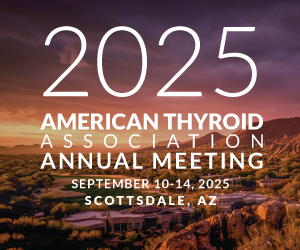
Medullary Thyroid Cancer
Danica M. Vodopivec, MD
The University of Texas MD Anderson Cancer Center
Houston, TX
March 24, 2022
Medullary thyroid cancer (MTC) is a rare thyroid malignancy and considered a neuroendocrine type of tumor. It originates from the parafollicular or C-cells of the thyroid, which are neural crest derivatives and produce a variety of biogenic amines, including calcitonin and carcinoembryonic antigen (CEA) ─ used as tumor markers. MTC represents up to 4% of thyroid cancer cases, and accounts for about 14% of all thyroid cancer related deaths(1,2).
MTC can be sporadic (or acquired via somatic mutation) in 75% of the cases and hereditary (or familial via germline mutation) in the remaining 25%, with the latter comprising the polyglandular cancer syndrome known as multiple endocrine neoplasia 2 (MEN2) types A and B. The RET oncogene is the most common genetic alteration in MTC, being present in 100% of MEN2 syndromes and in about 45% of sporadic MTC. Mutually exclusive point mutations of RAS has been reported in sporadic MTC but with less frequency (approximately 15%), and the remainder cases of sporadic MTC do not have identifiable mutations(3).
Many patients are diagnosed incidentally in the absence of symptoms, although some may experience compressive symptoms, diarrhea, and/or flushing. MTC is initially diagnosed by US-guided fine-needle aspiration (FNA) biopsy of a thyroid nodule. There are no distinctive ultrasound features between MTC and a follicular-derived thyroid cancer; hence, cytology findings suggestive of MTC should be further assessed with immunohistochemistry. MTC stains positive for calcitonin, chromogranin, and CEA, and negative for thyroglobulin. The advent of molecular genetic testing for thyroid nodules has significantly improved diagnosis among indeterminate FNA samples(4–7). After a cytological diagnosis of MTC (prior to surgery), the serum calcitonin and CEA levels should be measured followed by a genetic testing for a RET germline mutation. All patients with MTC should undergo genetic testing because up to 7% of apparent sporadic MTC are indeed de-novo hereditary mutations, meaning not inherited from either parent. In addition, up to 75% of patients with MEN2B have a de-novo germline RET mutation. It is important that pediatricians, primary providers, and dentists be able to recognize the characteristic MEN2B body features ─ including a marfanoid body habitus, eye abnormalities (thickened and everted eyelids and inability to produce tears), mucosal neuromas in the eyelids and aerodigestive tract (visible in the lips, tongue, nostrils), and diffuse ganglioneuromas of the gastrointestinal tract leading to chronic constipation, abdominal pain, and possible intestinal obstruction(1).
Total thyroidectomy with cervical lymph node dissection is the standard treatment. Unfortunately, there is only a 10% cure rate when cervical lymph nodes are involved at the time of initial surgery(1). Post-operative levothyroxine should be administered to maintain euthyroidism, and radioactive iodine treatment is not indicated. For persistent locoregional and/or distant metastases, repeat surgery, external beam radiation, or other focal therapies can be implemented. When these therapies are no longer options due to progressive or symptomatic disease, systemic therapy should be considered. There are 4 FDA approved kinase inhibitors for MTC. The non-selective multi-kinase inhibitors, vandetanib and cabozantinib(8,9), were the first drugs approved for MTC. The selective RET-inhibitors, selpercatinib and pralsetinib, were approved in 2020 and may be used as first or subsequent lines of therapy for RET mutated MTC(10,11). New treatments with immunotherapy, tumor vaccines, peptide receptor radionuclide therapy (PRRT) are being studied in clinical trials for MTC.
References:
1. Wells SA, Asa SL, Dralle H, et al. Revised American Thyroid Association guidelines for the management of medullary thyroid carcinoma. Thyroid 2015; 25: 567–610.
2. Roman S, Lin R, Sosa JA. Prognosis of medullary thyroid carcinoma: demographic, clinical, and pathologic predictors of survival in 1252 cases. Cancer 2006; 107: 2134–2142.
3. COSMIC https://cancer.sanger.ac.uk/cosmic.
4. Wirth LJ, Waguespack SG, Busaidy NL, et al. Genomic landscape of FNAs positive for medullary thyroid cancer (MTC) and potential impact on systemic therapy. JCO 2019; 37: 6087–6087.
5. Hu MI, Waguespack SG, Dosiou C, et al. Afirma Genomic Sequencing Classifier and Xpression Atlas Molecular Findings in Consecutive Bethesda III-VI Thyroid Nodules. J Clin Endocrinol Metab 2021; 106: 2198–2207.
6. Ciarletto AM, Narick C, Malchoff CD, et al. Analytical and clinical validation of pairwise microRNA expression analysis to identify medullary thyroid cancer in thyroid fine-needle aspiration samples. Cancer Cytopathol 2021; 129: 239–249.
7. Nikiforov YE, Baloch ZW. Clinical validation of the ThyroSeq v3 genomic classifier in thyroid nodules with indeterminate FNA cytology. Cancer Cytopathology 2019; 127: 225–230.
8. Wells SA, Robinson BG, Gagel RF, et al. Vandetanib in Patients With Locally Advanced or Metastatic Medullary Thyroid Cancer: A Randomized, Double-Blind Phase III Trial. JCO 2012; 30: 134–141.
9. Elisei R, Schlumberger MJ, Müller SP, et al. Cabozantinib in Progressive Medullary Thyroid Cancer. JCO 2013; 31: 3639–3646.
10. Wirth LJ, Sherman E, Robinson B, et al. Efficacy of Selpercatinib in RET -Altered Thyroid Cancers. N Engl J Med 2020; 383: 825–835.
11. Subbiah V, Hu MI, Wirth LJ, et al. Pralsetinib for patients with advanced or metastatic RET-altered thyroid cancer (ARROW): a multi-cohort, open-label, registrational, phase 1/2 study. The Lancet Diabetes & Endocrinology; 0. Epub ahead of print 9 June 2021. DOI: 10.1016/S2213-8587(21)00120-0.
Disclaimer:
The ideas and opinions expressed on the ATA Blogs do not necessarily reflect those of the ATA. None of the information posted is intended as medical, legal, or business advice, or advice about reimbursement for health care services. The mention of any product, service, company, therapy or physician practice does not constitute an endorsement of any kind by ATA. ATA assumes no responsibility for any injury or damage to persons or property arising out of or related to any use of the material contained in, posted on, or linked to this site, or any errors or omissions.
For more information on Thyroid Topics please visit: https://www.thyroid.org/thyroid-information/
We invite you to submit any questions or comments regarding this blog post below, for potential response in a future blog or social media post.



